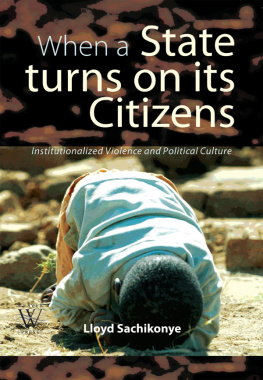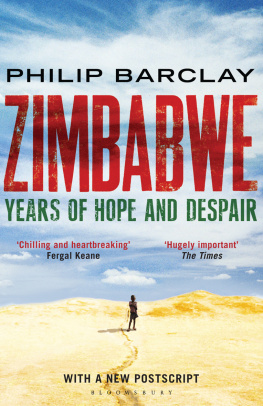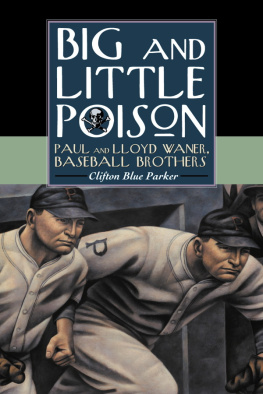When a State turns on its Citizens
When a State
turns on its
Citizens
60 years of Institutionalised Violence in Zimbabwe
Lloyd Sachikonye
First published by
Jacana Media (Pty) Ltd. (2011), Auckland Park 2092, South Africa
This edition published by Weaver Press, Zimbabwe 2011
and distributed by the African Book Collective
Lloyd Sachikonye 2011
National Archives of Zimbabwe for the photographs on pages xxi, xxii and 7
Gapwuz/CFU for the photograph on page 36
Tsvangirai Mukwazhi for the photographs on pages x, xv, xvi, 17, 23, 44, 59, 61, 77, 84, 89, 103, 106, 109
Cover design: Mike Danes
Typeset in Myriad Pro
Printed and Bound by Lightning Source
All rights reserved. No part of the publication may be reproduced, stored in a retrieval system or transmitted in any form by any means electronic, mechanical, photocopying, recording, or otherwise without the express written permission of the publisher.
For a complete list of Weaver Press titles see
www.weaverpresszimbabwe.com
ISBN: 978-1-77922-164-3
For Miriam, my mother,
who experienced coercion during the 2008 election
Acknowledgements
Many individuals and organizations kindly gave me their assistance in carrying out this study. A grant from the Harry Frank Guggenheim Foundation made it possible for me to undertake this study between October 2009 and May 2010 and I am very grateful for that support.
In the authoritarian environment of Zimbabwe, studying political violence is a difficult and sensitive enterprise. I am therefore greatly indebted to many people who assisted me in the course of this study. Many of them would prefer not to be named in a report of this nature.
I am profoundly grateful for the valuable assistance that I received at various stages of this project from the following people, amongst others: Eldred Masunungure and Geoff Feltoe at the University of Zimbabwe, Itai Zimunya at OSISA, Abel Chikomo at the Zimbabwe Human Rights NGO Forum; Brian Raftopoulos of the Solidarity Peace Trust (SPT), David Moore of the University of Johannesburg and Sarah Bracking of the University of Manchester. A number of institutions provided useful assistance: the Institute of Justice and Reconciliation and OSISA in South Africa; Counselling Services Unit, Catholic Commission for Justice and Peace (CCJP), Joint Monitoring and Implementation Committee (JOMIC), Research and Advocacy Unit (RAU), Women of Zimbabwe Arise (WOZA), Zimbabwe Congress of Trade Unions (ZCTU) and the Zimbabwe Human Rights NGO Forum in Harare and Bulawayo.
Finally but equally importantly, I am sincerely thankful to community members who spoke to me about their recollections or experiences of political violence in Bulawayo, south-western Zimbabwe, Epworth in Harare and Mutasa in eastern Zimbabwe.
Of course, I alone am responsible for any shortcomings in this study.
Lloyd Sachikonye
February 2011
Lloyd M. Sachikonye
Lloyd Sachikonye (1954) was born and educated in Zimbabwe. After attending Ahmadu Bello University in Nigeria where he did his M.Sc. in Political Science, he acquired a Ph.D. from Leeds University in the UK. He is Associate Professor at the Institute of Development Studies, University of Zimbabwe where he has worked as a researcher and lecturer since 1983.
On the Board of five professional international journals, he has also been widely published within his research field of the politics of labour movements, democracy, and civic society.
Table of Contents
Acronyms
Preface
Chapter 1: Background, History and Patterns of Political Violence
Introduction
Half a Century of Political Violence
Political Violence in the Nationalist Movement
Ramifications of Violence in a Liberation War
Colonial Regime Forces
Guerrilla Coercion and Violence
Violence in the Liberation Movements
Other Forms of Violence
Party-linked Militia
ZANLA-ZIPRA clashes
Significance of the Gukurahundi Violence
Election-related Violence
Institutionalized Violence
Other Examples of State Repression
External Military Intervention
Repression of Food Riots
Repression of Workers and Students
Violence in Operation Restore Order/Murambatsvina
Chapter 2: Political Violence and the Scramble for Resources
Introduction
Explaining Inter-party Violence
Significance of Intra-party Violence
Violence and Land Reform
Coercive Accumulation
Impunity of State Institutions and Agents
Power, Ideology and Violence
Chapter 3: Systemic Violence and the 2008 Election
Introduction
Political Context and the Electoral System
Systemic Violence and State Institutions
Episodes of Violence and Terror
Outcome of the Run-off Election
Economic Penalties on the Opposition
Chapter 4: Violence and Political Culture
Introduction
Inter-party Violence in 2000-2008
Intra-party Violence in 2000-2008
Violence and Civil Society Organizations (CSOs) in 2000-2008
Labour
Teachers
Students
Pressure Groups
Media
NGOs and the Churches
Violence against Women
Effects of Violence on Political Culture
Chapter 5: Wider Impact of Political Violence on Society
Introduction
Violence, Trauma and Fear
Effects of Impunity
Restitution or retribution?
Youth: the lost generation?
Conclusion and Afterword
Bibliography
Appendix 1: A Note on Methodology
Tables and Boxes
Tables
Table 1 Cases of gross human rights violations
Table 2 Frequency of alleged perpetrators
Table 3 Freeness and fairness of elections, 1999-2003
Table 4 Expectations about freeness and fairness in future elections
Table 5 Decline in voter participation, 1980-2008
Table 6 Attitude towards perpetrators
Table 7 Victim of intimidation, threat or harassment by party
Table 8 Whether respondent has experienced intimidation, threat or harassment
Boxes
Box 1 Six deaths at Chiweshe
Box 2 Epworth: violence and terror against the opposition
Box 3 Beatings in Chitungwiza by soldiers
Box 4 Violence and terror in Chikomba
Box 5 Buhera study site
Box 6 Chitungwiza violence
Box 7 Terror in a Mutasa community
Box 8 Torture of a labour leader, 2006
Box 9 Extra-judicial restitution in Buhera, 2010
Box 10 Hallucinations
Box 11 Youth militia in their own words
ACPD | African Community Publishing and Development |
ANC | African National Congress |
APs | Assembly Points |
BOG |













